Analyzing the Impact of Hygiene Standards on Health Care Delivery
VerifiedAdded on 2023/06/05
|7
|1605
|179
Essay
AI Summary
This essay discusses the critical role of hygiene in healthcare settings, highlighting that low hygiene standards are a major cause of healthcare-associated infections, leading to increased patient morbidity and mortality. It emphasizes that contaminated hands and environments are primary transmission routes, making hand hygiene a crucial preventive measure. The essay explores various factors influencing hygiene practices, including resource availability, healthcare worker attitudes, patient hospitalization, social practices, and socioeconomic status. It recommends adopting WHO guidelines, improving hospital resource allocation, addressing cultural factors, and ensuring surgical instrument cleanliness. The author advocates for responsible hygiene practices among healthcare professionals and the implementation of self-cleaning technologies to enhance hygiene levels and reduce healthcare-associated infections. Desklib provides this essay and other resources to aid students in their studies.

Running head: HYGIENE
Student Name
Student No.
Unit
Title: Health Care Hygiene
Student Name
Student No.
Unit
Title: Health Care Hygiene
Paraphrase This Document
Need a fresh take? Get an instant paraphrase of this document with our AI Paraphraser
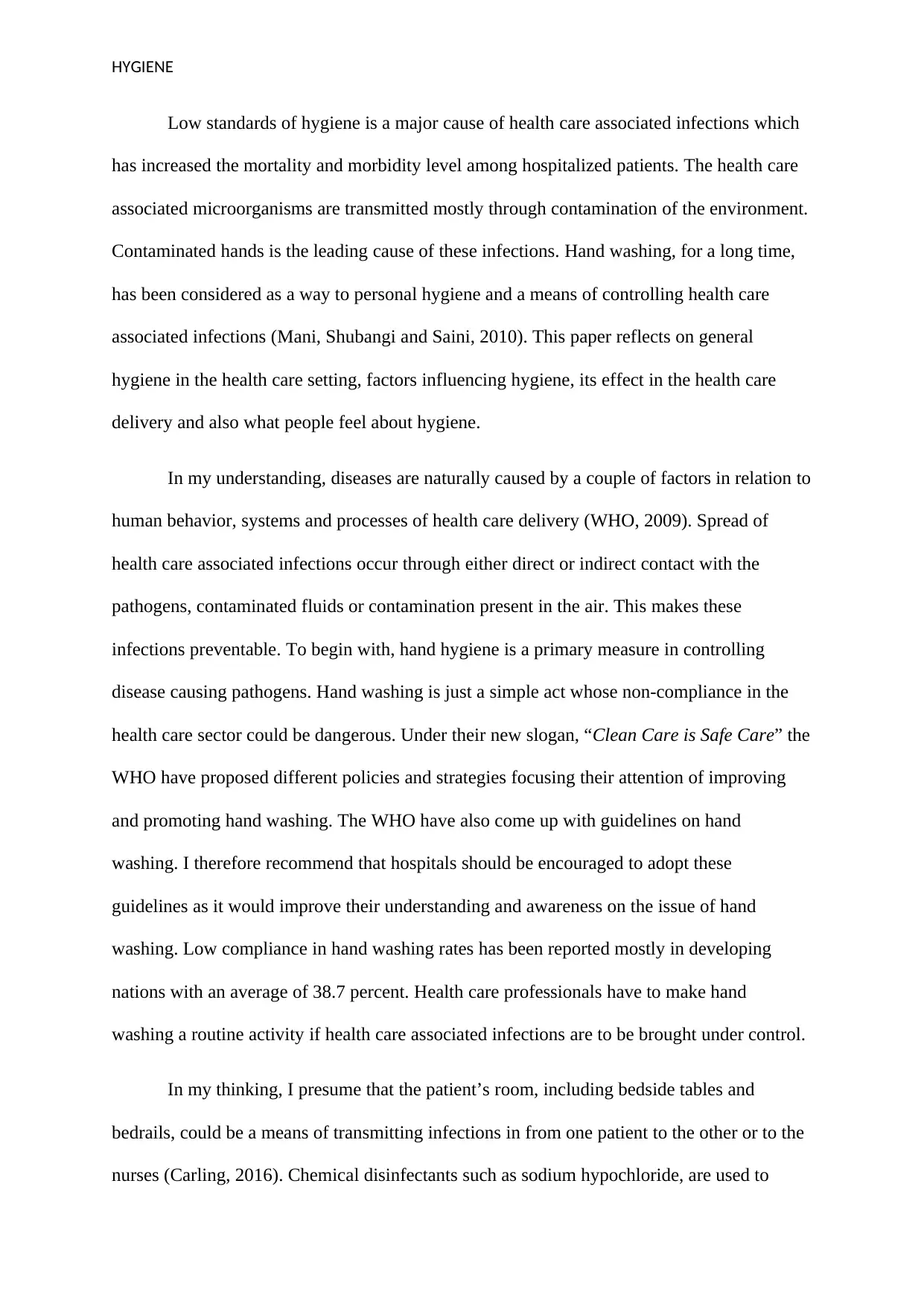
HYGIENE
Low standards of hygiene is a major cause of health care associated infections which
has increased the mortality and morbidity level among hospitalized patients. The health care
associated microorganisms are transmitted mostly through contamination of the environment.
Contaminated hands is the leading cause of these infections. Hand washing, for a long time,
has been considered as a way to personal hygiene and a means of controlling health care
associated infections (Mani, Shubangi and Saini, 2010). This paper reflects on general
hygiene in the health care setting, factors influencing hygiene, its effect in the health care
delivery and also what people feel about hygiene.
In my understanding, diseases are naturally caused by a couple of factors in relation to
human behavior, systems and processes of health care delivery (WHO, 2009). Spread of
health care associated infections occur through either direct or indirect contact with the
pathogens, contaminated fluids or contamination present in the air. This makes these
infections preventable. To begin with, hand hygiene is a primary measure in controlling
disease causing pathogens. Hand washing is just a simple act whose non-compliance in the
health care sector could be dangerous. Under their new slogan, “Clean Care is Safe Care” the
WHO have proposed different policies and strategies focusing their attention of improving
and promoting hand washing. The WHO have also come up with guidelines on hand
washing. I therefore recommend that hospitals should be encouraged to adopt these
guidelines as it would improve their understanding and awareness on the issue of hand
washing. Low compliance in hand washing rates has been reported mostly in developing
nations with an average of 38.7 percent. Health care professionals have to make hand
washing a routine activity if health care associated infections are to be brought under control.
In my thinking, I presume that the patient’s room, including bedside tables and
bedrails, could be a means of transmitting infections in from one patient to the other or to the
nurses (Carling, 2016). Chemical disinfectants such as sodium hypochloride, are used to
Low standards of hygiene is a major cause of health care associated infections which
has increased the mortality and morbidity level among hospitalized patients. The health care
associated microorganisms are transmitted mostly through contamination of the environment.
Contaminated hands is the leading cause of these infections. Hand washing, for a long time,
has been considered as a way to personal hygiene and a means of controlling health care
associated infections (Mani, Shubangi and Saini, 2010). This paper reflects on general
hygiene in the health care setting, factors influencing hygiene, its effect in the health care
delivery and also what people feel about hygiene.
In my understanding, diseases are naturally caused by a couple of factors in relation to
human behavior, systems and processes of health care delivery (WHO, 2009). Spread of
health care associated infections occur through either direct or indirect contact with the
pathogens, contaminated fluids or contamination present in the air. This makes these
infections preventable. To begin with, hand hygiene is a primary measure in controlling
disease causing pathogens. Hand washing is just a simple act whose non-compliance in the
health care sector could be dangerous. Under their new slogan, “Clean Care is Safe Care” the
WHO have proposed different policies and strategies focusing their attention of improving
and promoting hand washing. The WHO have also come up with guidelines on hand
washing. I therefore recommend that hospitals should be encouraged to adopt these
guidelines as it would improve their understanding and awareness on the issue of hand
washing. Low compliance in hand washing rates has been reported mostly in developing
nations with an average of 38.7 percent. Health care professionals have to make hand
washing a routine activity if health care associated infections are to be brought under control.
In my thinking, I presume that the patient’s room, including bedside tables and
bedrails, could be a means of transmitting infections in from one patient to the other or to the
nurses (Carling, 2016). Chemical disinfectants such as sodium hypochloride, are used to
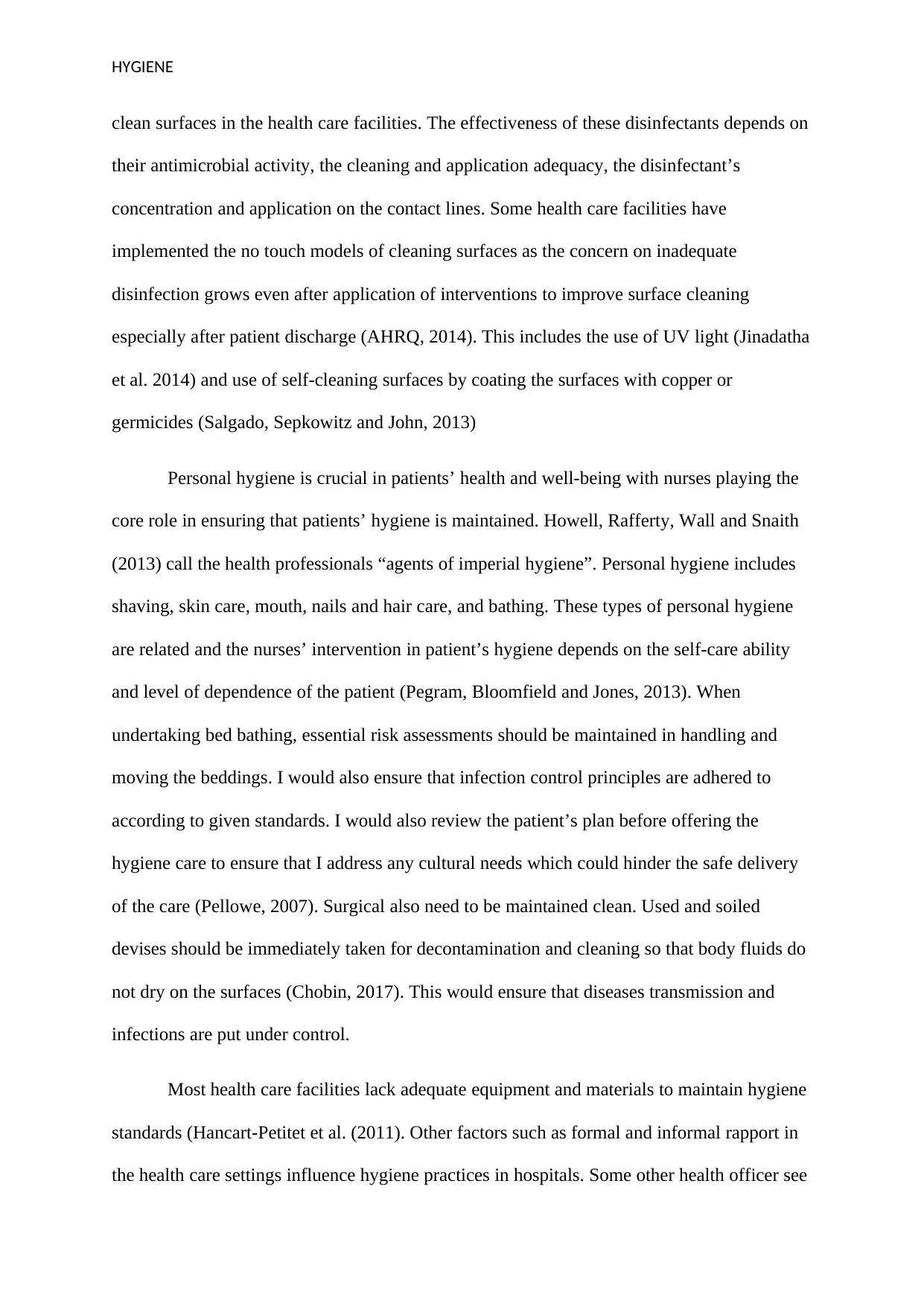
HYGIENE
clean surfaces in the health care facilities. The effectiveness of these disinfectants depends on
their antimicrobial activity, the cleaning and application adequacy, the disinfectant’s
concentration and application on the contact lines. Some health care facilities have
implemented the no touch models of cleaning surfaces as the concern on inadequate
disinfection grows even after application of interventions to improve surface cleaning
especially after patient discharge (AHRQ, 2014). This includes the use of UV light (Jinadatha
et al. 2014) and use of self-cleaning surfaces by coating the surfaces with copper or
germicides (Salgado, Sepkowitz and John, 2013)
Personal hygiene is crucial in patients’ health and well-being with nurses playing the
core role in ensuring that patients’ hygiene is maintained. Howell, Rafferty, Wall and Snaith
(2013) call the health professionals “agents of imperial hygiene”. Personal hygiene includes
shaving, skin care, mouth, nails and hair care, and bathing. These types of personal hygiene
are related and the nurses’ intervention in patient’s hygiene depends on the self-care ability
and level of dependence of the patient (Pegram, Bloomfield and Jones, 2013). When
undertaking bed bathing, essential risk assessments should be maintained in handling and
moving the beddings. I would also ensure that infection control principles are adhered to
according to given standards. I would also review the patient’s plan before offering the
hygiene care to ensure that I address any cultural needs which could hinder the safe delivery
of the care (Pellowe, 2007). Surgical also need to be maintained clean. Used and soiled
devises should be immediately taken for decontamination and cleaning so that body fluids do
not dry on the surfaces (Chobin, 2017). This would ensure that diseases transmission and
infections are put under control.
Most health care facilities lack adequate equipment and materials to maintain hygiene
standards (Hancart-Petitet et al. (2011). Other factors such as formal and informal rapport in
the health care settings influence hygiene practices in hospitals. Some other health officer see
clean surfaces in the health care facilities. The effectiveness of these disinfectants depends on
their antimicrobial activity, the cleaning and application adequacy, the disinfectant’s
concentration and application on the contact lines. Some health care facilities have
implemented the no touch models of cleaning surfaces as the concern on inadequate
disinfection grows even after application of interventions to improve surface cleaning
especially after patient discharge (AHRQ, 2014). This includes the use of UV light (Jinadatha
et al. 2014) and use of self-cleaning surfaces by coating the surfaces with copper or
germicides (Salgado, Sepkowitz and John, 2013)
Personal hygiene is crucial in patients’ health and well-being with nurses playing the
core role in ensuring that patients’ hygiene is maintained. Howell, Rafferty, Wall and Snaith
(2013) call the health professionals “agents of imperial hygiene”. Personal hygiene includes
shaving, skin care, mouth, nails and hair care, and bathing. These types of personal hygiene
are related and the nurses’ intervention in patient’s hygiene depends on the self-care ability
and level of dependence of the patient (Pegram, Bloomfield and Jones, 2013). When
undertaking bed bathing, essential risk assessments should be maintained in handling and
moving the beddings. I would also ensure that infection control principles are adhered to
according to given standards. I would also review the patient’s plan before offering the
hygiene care to ensure that I address any cultural needs which could hinder the safe delivery
of the care (Pellowe, 2007). Surgical also need to be maintained clean. Used and soiled
devises should be immediately taken for decontamination and cleaning so that body fluids do
not dry on the surfaces (Chobin, 2017). This would ensure that diseases transmission and
infections are put under control.
Most health care facilities lack adequate equipment and materials to maintain hygiene
standards (Hancart-Petitet et al. (2011). Other factors such as formal and informal rapport in
the health care settings influence hygiene practices in hospitals. Some other health officer see
⊘ This is a preview!⊘
Do you want full access?
Subscribe today to unlock all pages.

Trusted by 1+ million students worldwide
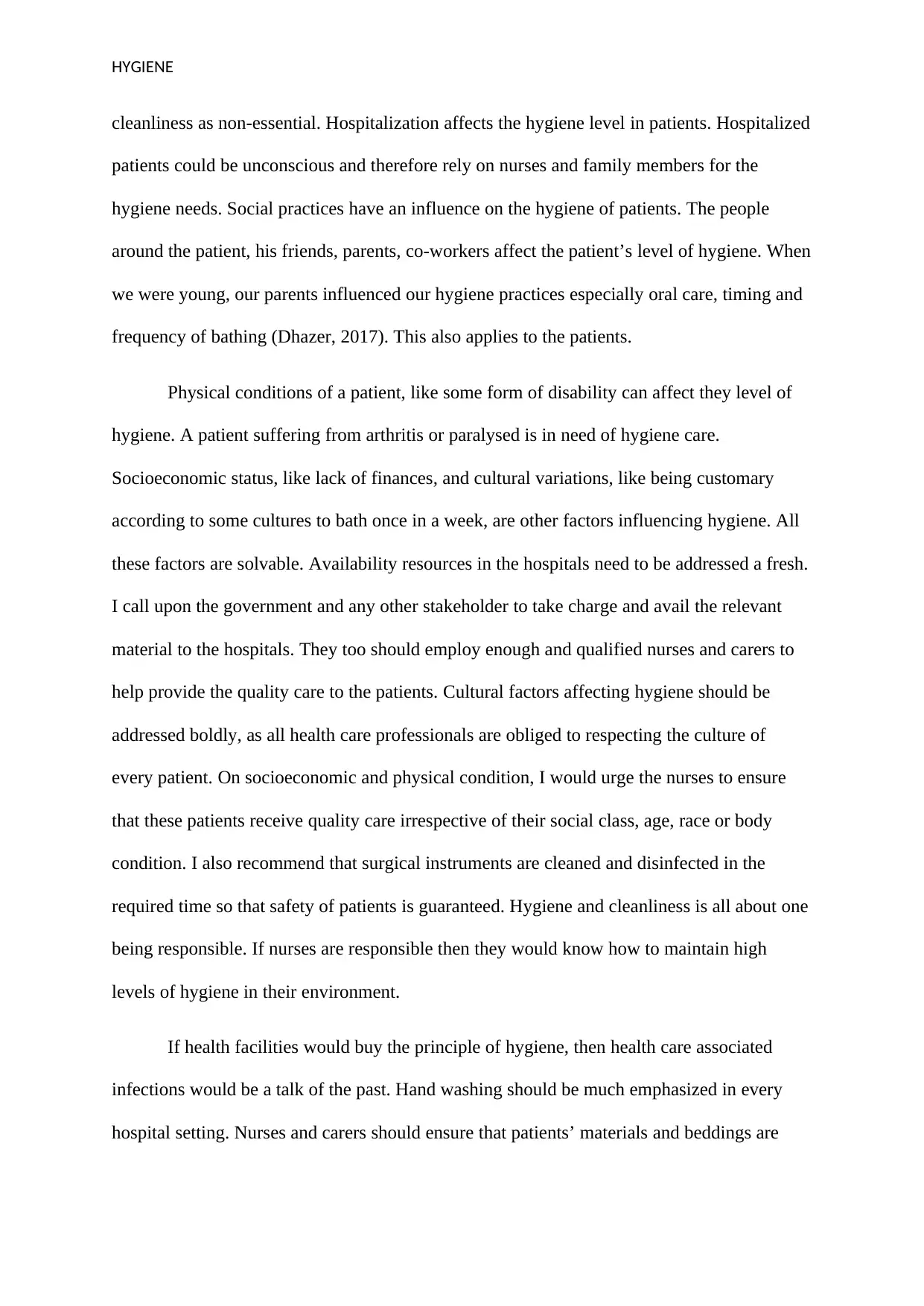
HYGIENE
cleanliness as non-essential. Hospitalization affects the hygiene level in patients. Hospitalized
patients could be unconscious and therefore rely on nurses and family members for the
hygiene needs. Social practices have an influence on the hygiene of patients. The people
around the patient, his friends, parents, co-workers affect the patient’s level of hygiene. When
we were young, our parents influenced our hygiene practices especially oral care, timing and
frequency of bathing (Dhazer, 2017). This also applies to the patients.
Physical conditions of a patient, like some form of disability can affect they level of
hygiene. A patient suffering from arthritis or paralysed is in need of hygiene care.
Socioeconomic status, like lack of finances, and cultural variations, like being customary
according to some cultures to bath once in a week, are other factors influencing hygiene. All
these factors are solvable. Availability resources in the hospitals need to be addressed a fresh.
I call upon the government and any other stakeholder to take charge and avail the relevant
material to the hospitals. They too should employ enough and qualified nurses and carers to
help provide the quality care to the patients. Cultural factors affecting hygiene should be
addressed boldly, as all health care professionals are obliged to respecting the culture of
every patient. On socioeconomic and physical condition, I would urge the nurses to ensure
that these patients receive quality care irrespective of their social class, age, race or body
condition. I also recommend that surgical instruments are cleaned and disinfected in the
required time so that safety of patients is guaranteed. Hygiene and cleanliness is all about one
being responsible. If nurses are responsible then they would know how to maintain high
levels of hygiene in their environment.
If health facilities would buy the principle of hygiene, then health care associated
infections would be a talk of the past. Hand washing should be much emphasized in every
hospital setting. Nurses and carers should ensure that patients’ materials and beddings are
cleanliness as non-essential. Hospitalization affects the hygiene level in patients. Hospitalized
patients could be unconscious and therefore rely on nurses and family members for the
hygiene needs. Social practices have an influence on the hygiene of patients. The people
around the patient, his friends, parents, co-workers affect the patient’s level of hygiene. When
we were young, our parents influenced our hygiene practices especially oral care, timing and
frequency of bathing (Dhazer, 2017). This also applies to the patients.
Physical conditions of a patient, like some form of disability can affect they level of
hygiene. A patient suffering from arthritis or paralysed is in need of hygiene care.
Socioeconomic status, like lack of finances, and cultural variations, like being customary
according to some cultures to bath once in a week, are other factors influencing hygiene. All
these factors are solvable. Availability resources in the hospitals need to be addressed a fresh.
I call upon the government and any other stakeholder to take charge and avail the relevant
material to the hospitals. They too should employ enough and qualified nurses and carers to
help provide the quality care to the patients. Cultural factors affecting hygiene should be
addressed boldly, as all health care professionals are obliged to respecting the culture of
every patient. On socioeconomic and physical condition, I would urge the nurses to ensure
that these patients receive quality care irrespective of their social class, age, race or body
condition. I also recommend that surgical instruments are cleaned and disinfected in the
required time so that safety of patients is guaranteed. Hygiene and cleanliness is all about one
being responsible. If nurses are responsible then they would know how to maintain high
levels of hygiene in their environment.
If health facilities would buy the principle of hygiene, then health care associated
infections would be a talk of the past. Hand washing should be much emphasized in every
hospital setting. Nurses and carers should ensure that patients’ materials and beddings are
Paraphrase This Document
Need a fresh take? Get an instant paraphrase of this document with our AI Paraphraser

HYGIENE
attended to appropriately. Introducing the self-cleaning technology in health care would boost
the levels of hygiene a great deal.
attended to appropriately. Introducing the self-cleaning technology in health care would boost
the levels of hygiene a great deal.
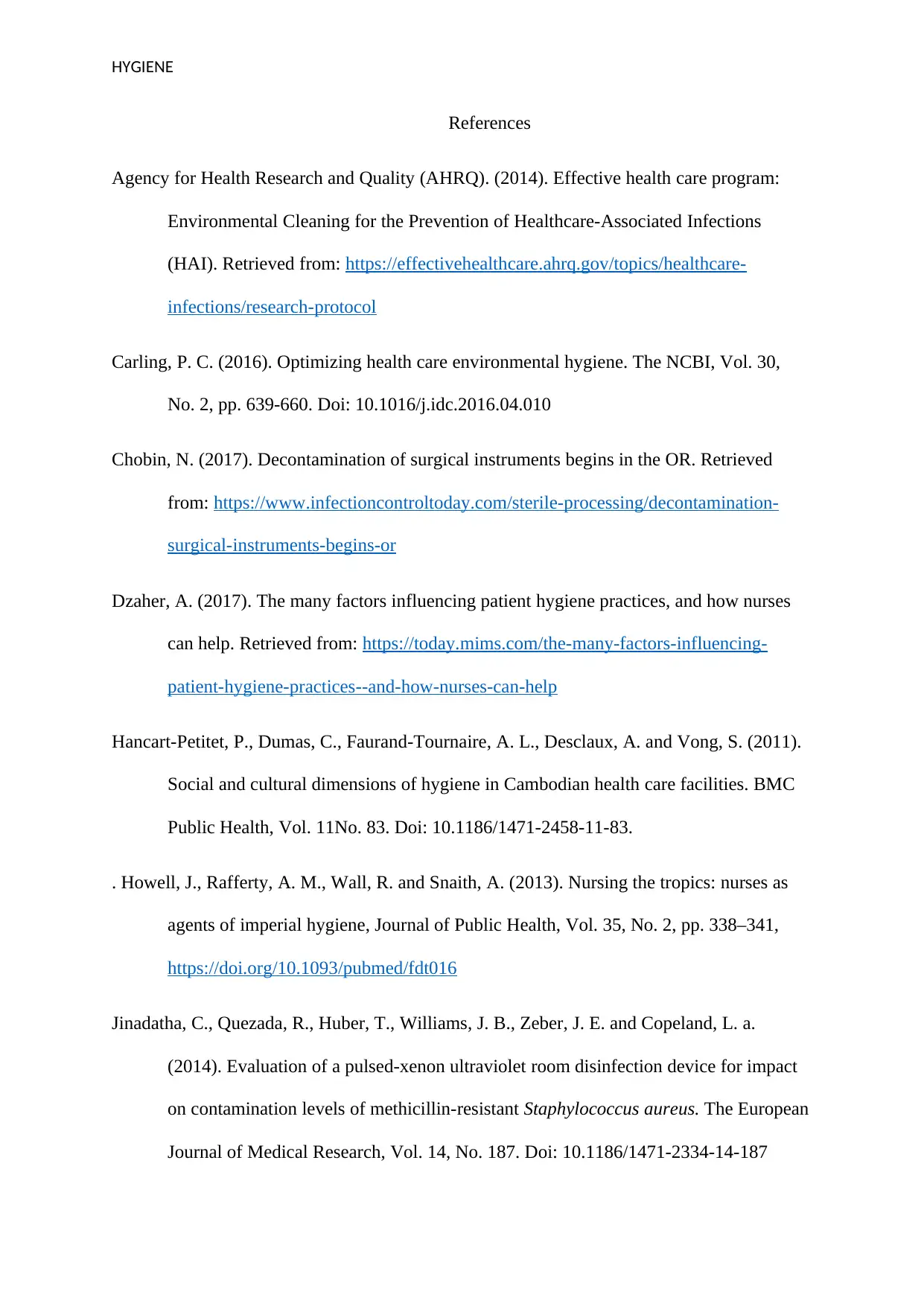
HYGIENE
References
Agency for Health Research and Quality (AHRQ). (2014). Effective health care program:
Environmental Cleaning for the Prevention of Healthcare-Associated Infections
(HAI). Retrieved from: https://effectivehealthcare.ahrq.gov/topics/healthcare-
infections/research-protocol
Carling, P. C. (2016). Optimizing health care environmental hygiene. The NCBI, Vol. 30,
No. 2, pp. 639-660. Doi: 10.1016/j.idc.2016.04.010
Chobin, N. (2017). Decontamination of surgical instruments begins in the OR. Retrieved
from: https://www.infectioncontroltoday.com/sterile-processing/decontamination-
surgical-instruments-begins-or
Dzaher, A. (2017). The many factors influencing patient hygiene practices, and how nurses
can help. Retrieved from: https://today.mims.com/the-many-factors-influencing-
patient-hygiene-practices--and-how-nurses-can-help
Hancart-Petitet, P., Dumas, C., Faurand-Tournaire, A. L., Desclaux, A. and Vong, S. (2011).
Social and cultural dimensions of hygiene in Cambodian health care facilities. BMC
Public Health, Vol. 11No. 83. Doi: 10.1186/1471-2458-11-83.
. Howell, J., Rafferty, A. M., Wall, R. and Snaith, A. (2013). Nursing the tropics: nurses as
agents of imperial hygiene, Journal of Public Health, Vol. 35, No. 2, pp. 338–341,
https://doi.org/10.1093/pubmed/fdt016
Jinadatha, C., Quezada, R., Huber, T., Williams, J. B., Zeber, J. E. and Copeland, L. a.
(2014). Evaluation of a pulsed-xenon ultraviolet room disinfection device for impact
on contamination levels of methicillin-resistant Staphylococcus aureus. The European
Journal of Medical Research, Vol. 14, No. 187. Doi: 10.1186/1471-2334-14-187
References
Agency for Health Research and Quality (AHRQ). (2014). Effective health care program:
Environmental Cleaning for the Prevention of Healthcare-Associated Infections
(HAI). Retrieved from: https://effectivehealthcare.ahrq.gov/topics/healthcare-
infections/research-protocol
Carling, P. C. (2016). Optimizing health care environmental hygiene. The NCBI, Vol. 30,
No. 2, pp. 639-660. Doi: 10.1016/j.idc.2016.04.010
Chobin, N. (2017). Decontamination of surgical instruments begins in the OR. Retrieved
from: https://www.infectioncontroltoday.com/sterile-processing/decontamination-
surgical-instruments-begins-or
Dzaher, A. (2017). The many factors influencing patient hygiene practices, and how nurses
can help. Retrieved from: https://today.mims.com/the-many-factors-influencing-
patient-hygiene-practices--and-how-nurses-can-help
Hancart-Petitet, P., Dumas, C., Faurand-Tournaire, A. L., Desclaux, A. and Vong, S. (2011).
Social and cultural dimensions of hygiene in Cambodian health care facilities. BMC
Public Health, Vol. 11No. 83. Doi: 10.1186/1471-2458-11-83.
. Howell, J., Rafferty, A. M., Wall, R. and Snaith, A. (2013). Nursing the tropics: nurses as
agents of imperial hygiene, Journal of Public Health, Vol. 35, No. 2, pp. 338–341,
https://doi.org/10.1093/pubmed/fdt016
Jinadatha, C., Quezada, R., Huber, T., Williams, J. B., Zeber, J. E. and Copeland, L. a.
(2014). Evaluation of a pulsed-xenon ultraviolet room disinfection device for impact
on contamination levels of methicillin-resistant Staphylococcus aureus. The European
Journal of Medical Research, Vol. 14, No. 187. Doi: 10.1186/1471-2334-14-187
⊘ This is a preview!⊘
Do you want full access?
Subscribe today to unlock all pages.

Trusted by 1+ million students worldwide
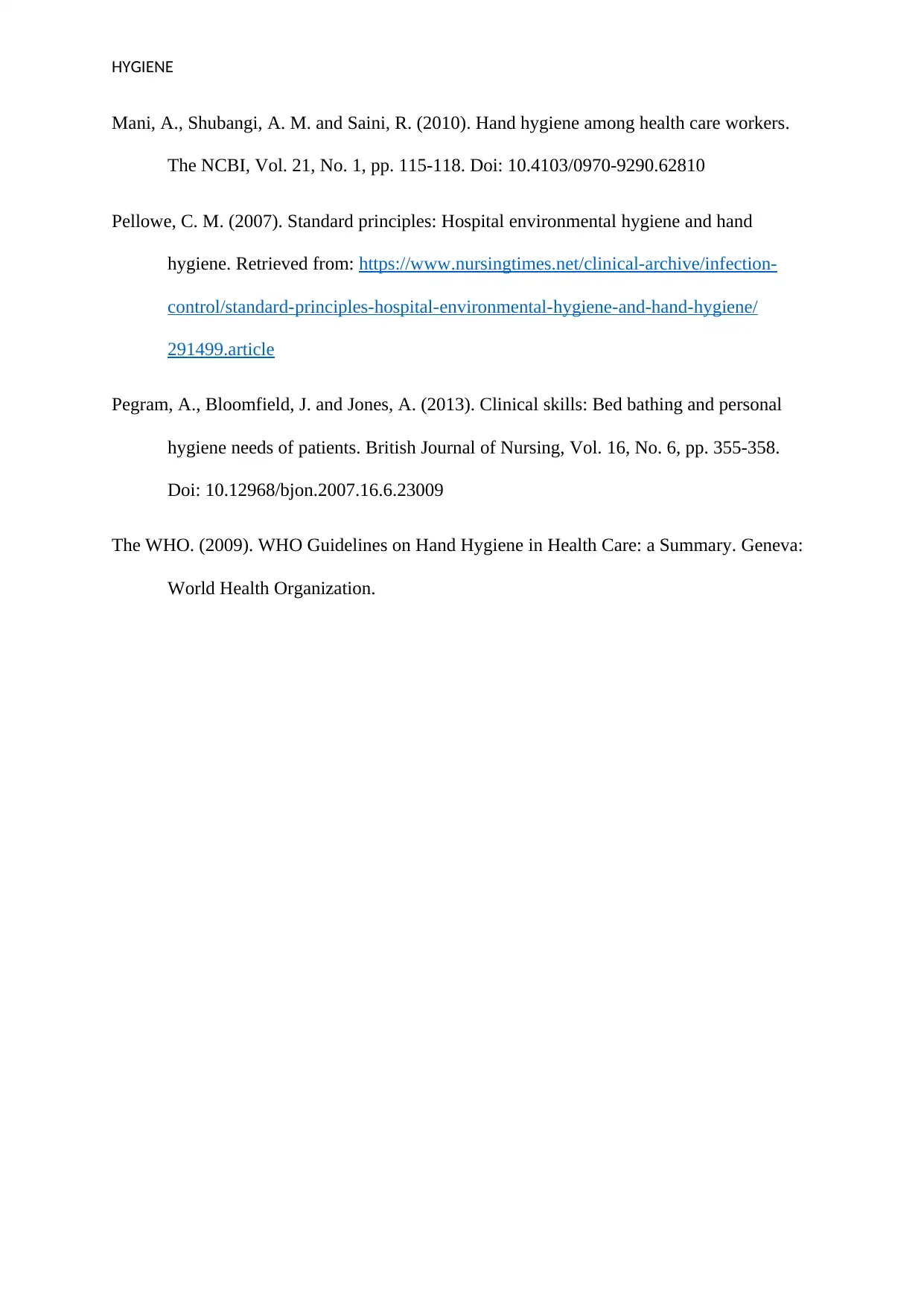
HYGIENE
Mani, A., Shubangi, A. M. and Saini, R. (2010). Hand hygiene among health care workers.
The NCBI, Vol. 21, No. 1, pp. 115-118. Doi: 10.4103/0970-9290.62810
Pellowe, C. M. (2007). Standard principles: Hospital environmental hygiene and hand
hygiene. Retrieved from: https://www.nursingtimes.net/clinical-archive/infection-
control/standard-principles-hospital-environmental-hygiene-and-hand-hygiene/
291499.article
Pegram, A., Bloomfield, J. and Jones, A. (2013). Clinical skills: Bed bathing and personal
hygiene needs of patients. British Journal of Nursing, Vol. 16, No. 6, pp. 355-358.
Doi: 10.12968/bjon.2007.16.6.23009
The WHO. (2009). WHO Guidelines on Hand Hygiene in Health Care: a Summary. Geneva:
World Health Organization.
Mani, A., Shubangi, A. M. and Saini, R. (2010). Hand hygiene among health care workers.
The NCBI, Vol. 21, No. 1, pp. 115-118. Doi: 10.4103/0970-9290.62810
Pellowe, C. M. (2007). Standard principles: Hospital environmental hygiene and hand
hygiene. Retrieved from: https://www.nursingtimes.net/clinical-archive/infection-
control/standard-principles-hospital-environmental-hygiene-and-hand-hygiene/
291499.article
Pegram, A., Bloomfield, J. and Jones, A. (2013). Clinical skills: Bed bathing and personal
hygiene needs of patients. British Journal of Nursing, Vol. 16, No. 6, pp. 355-358.
Doi: 10.12968/bjon.2007.16.6.23009
The WHO. (2009). WHO Guidelines on Hand Hygiene in Health Care: a Summary. Geneva:
World Health Organization.
1 out of 7
Related Documents
Your All-in-One AI-Powered Toolkit for Academic Success.
+13062052269
info@desklib.com
Available 24*7 on WhatsApp / Email
![[object Object]](/_next/static/media/star-bottom.7253800d.svg)
Unlock your academic potential
Copyright © 2020–2025 A2Z Services. All Rights Reserved. Developed and managed by ZUCOL.





